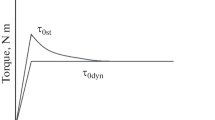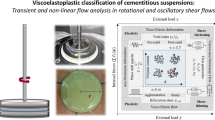Abstract
The introduction of a new generation of dispersants in concrete allow this material to exhibit self-compacting properties in its fresh state and high durability and mechanical strength in its hardened state. These properties translate into many practical advantages for the construction field.Two of the most important are reducing the ecological impact of this sector of industry and reducing the labor-intensive work associated with placing ordinary concrete by vibration. In this article, it will be shown that knowledge of colloidal science has proven essential in the development of this new generation of dispersants for concrete. Indeed, the polymer molecules used in these dispersants are specifically designed to induce steric repulsion between cement particles, reducing their agglomeration and allowing high workability of fresh concrete prior to setting. While the linkage between interparticle forces and the rheological behavior of cement pastes is still only semiquantitative, recent advances in the modeling of concrete rheology show very promising results in terms of handling aggregates with a wide distribution of particle sizes and shapes. However, accurate modeling requires reliable input on the interaction of the dispersant with the hydrating cement at the molecular level, which is identified as a future research challenge.
Similar content being viewed by others
References
P.K Mehta, in Proc. of the 6th CANMET/ACI International Conference on Fly-Ash, Silica Fume, Slag and Natural Pozzolans in Concrete, Vol.1, edited by V.M. Malhotra (American Concrete Institute, Detroit, 1998) p.1.
V.H. Dodson, Concrete Admixtures (Van Nostrand Reinhold, New York, 1990).
P.C. Aïtcin, C. Jolicoeur and J.G. MacGregor, Concr. Int. 16 (5) (1994) p.45.
V.S. Ramachandran, V.M. Malhotra, C. Jolicoeur, and N. Spiratos Superplasticizers: Properties and Applications in Concrete, CANMET Publication MTL 97-14 (CANMET, Ottawa, 1998).
R.J. Flatt, Cem. Concr. Res. 34 (2004) p.399.
R.J. Flatt, in Polymers in Particulate Systems: Properties and Applications, edited by V.A. Hackley, P. Somasundaran, and J.A. Lewis (Marcel Dekker, New York, 2001) p.247.
J.A. Lewis, H. Matsuyama G. Kirby S. Morissette, and J.F. Young, J.Am. Ceram. Soc. 83 (2000) p.1905.
W.A. Ducker, T.J. Senden, and R.M. Pashley, Nature 353 (1991) p.239.
A. Kauppi P.F.B. Banfill P. Bowen L. Galmiche, Y.F. Houst, F. Lafuma U. Mäder, F. Perche B.G. Petersen, K. Reknes I. Schober A. Siebold and D. Swift in Proc. 11th Int. Congr. on the Chemistry of Cement, Vol. 2, edited by G. Grieve and G. Owen (Cement Association of Canada, Ottawa, 2003) p.528.
A. Kauppi K.M. Andersson, and L. Bergström, “Probing the Effect of Superplasti-cizer Adsorption on the Surface Forces Using the Colloidal Probe AFM Technique,” Cem. Concr. Res. submitted for publication.
R.J. Flatt, Y.F. Houst, P. Bowen H. Hofmann J. Widmer U. Sulser U. Maeder and T.A. Bürge, in Proc. 5th CANMET/ACI Int. Conf. on Superplasticizers and Other Chemical Admixtures in Concrete, edited by V.M. Malhotra (American Concrete Institute, Detroit, 1997) p.743.
H.G. Pedersen, “Particle interactions: An AFM study of colloidal systems,” PhD thesis, Technical University of Denmark, 1998.
H. Van Damme, S. Mansoutre P. Colombet C. Lesaffre and D. Picart C.R. Physique 3 (2002) p.229.
T.C. Powers, The Properties of Fresh Concrete (John Wiley & Sons, New York, 1968).
F. de Larrard, Concrete Mixture Proportioning: A Scientific Approach (E&FN Spon, London, 1999).
D. Bonen and S.L. Sarkar, Cem. Concr. Res. 25 (1995) p.1423.
V. Fernon A. Vichot N. Le Goanvic, P. Colombet F. Corazza and U. Costa in Proc. 5th CANMET/ACI Int. Conf. on Superplasticizers and Other Chemical Admixtures in Concrete, edited by V.M. Malhotra (American Concrete Institute, Detroit, 1997) p.225.
R.J. Flatt and Y.F. Houst, Cem. Concr. Res. 31 (2001) p.1169.
K. Yamada and S. Hanehara Concr. Sci. and Eng. 3 (2001) p.135.
R.J. Flatt, “Towards a Prediction of Super-plasticized Concrete Rheology,” Mater. and Struct. in press.
P.J. Hoogerbrugge and Koelman J.M.V.A. Europhys. Lett. 19 (1992) p.155.
R. Peyret and D. Taylor Computational Methods for Fluid Flow (Springer-Verlag, New York, 1983).
M.P. Allen and D.J. Tildesley, Computer Simulation of Liquids (Clarendon Press, Oxford, 1987).
P. Espanol and P. Warren Europhys. Lett. 30 (1995) p.191.
C. Marsh G. Backx and M.H. Ernst, Euro-phys. Lett. 38 (1997) p.441.
J.M.V.A. Koelman and P.J. Hoogerbrugge, Europhys. Lett. 21 (1993) p.363.
E.J. Garboczi, Cem. Conc. Res. 32 (2002) p.1621.
C. Ferraris and N. Martys J. Res. Natl. Inst. Stand. Technol. 108 (2003) p.229.
Rights and permissions
About this article
Cite this article
Flatt, R.J., Martys, N. & Bergström, L. The Rheology of Cementitious Materials. MRS Bulletin 29, 314–318 (2004). https://doi.org/10.1557/mrs2004.96
Published:
Issue Date:
DOI: https://doi.org/10.1557/mrs2004.96




